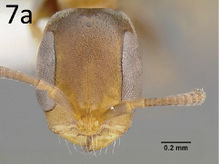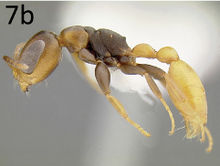Key to Pseudomyrmex goeldii group species
This worker and queen key is based on: Ward, P.S. 2017. A review of the Pseudomyrmex ferrugineus and Pseudomyrmex goeldii species groups: acacia-ants and relatives (Hymenoptera: Formicidae). Zootaxa. 4227:524–542. (doi: 10.11646/zootaxa.4227.4.3).
Key to species of the P. goeldii group, based on the workers and queens. Sample sizes of measurements are given (e.g., n = 5). Unless otherwise noted, sample sizes are the same for all measurements of a given caste cited within any particular lug of a couplet.
You may also be interested in
1
- Front of head between compound eyes densely punctulate, the punctures separated by their diameters or less, becoming smooth and sparsely punctulate around the ocelli; mesosoma with dense coriarious-imbricate sculpture, and wholly opaque; petiole without erect setae . . . . . 2
- Front of head smooth, shiny, and sparsely puncticulate; mesosoma less densely sculptured, appearance shinier, especially on the pronotum; petiole with a pair of erect setae . . . . . 3
2
return to couplet #1
- Larger species (worker HW 0.71–0.78, n = 9; queen HW 0.70–0.73, n = 3) with broader head (worker CI 0.80–0.85, queen CI 0.75–0.78); standing pilosity absent from mesosoma; Costa Rica to Peru and Brazil . . . . . Pseudomyrmex obtusus
- Smaller species (worker HW 0.56–0.60, n = 3; queen HW 0.58, n = 1) with a more elongate head (worker CI 0.75–0.78, queen CI 0.68); standing pilosity present on the mesosoma as a single pair on the pronotal humeri; Brazil, Bolivia . . . . . Pseudomyrmex parvulus
3
return to couplet #1
- Larger species (worker HW 0.65–0.66, n = 3; queen unknown, but expected to have similar HW) with shorter eyes (worker REL 0.55–0.56; worker REL2 0.69–0.73); southeastern Brazil . . . . . Pseudomyrmex goeldii
- Smaller species (worker HW 0.47–0.55, n = 22; queen HW 0.49–0.54, n = 9) with more elongate eyes (worker REL 0.57–0.64; worker REL2 0.75–0.87; queen REL 0.55–0.61; queen REL2 0.80–0.90); Nicaragua to Bolivia and central Brazil . . . . . 4
4
return to couplet #3
- Mesosoma sculpture weaker, especially on the metapleuron, which is partly smooth and shining; juncture of the dorsal and declivitous faces of the propodeum subangulate in worker; petiole relatively low and broad (worker PLI 0.64–0.69, DPW/PH 0.88–0.92; n = 6) and with anterodorsal face more gently sloping than posterodorsal face (Fig. 6b); worker REL2 0.75–0.80; Peru, Bolivia . . . . . Pseudomyrmex micans
- Mesosoma sculpture better developed, the metapleuron coriarious-reticulate and subopaque, smooth shiny patches less well developed; in areas of apparent overlap with P. micans (Peru and Bolivia) worker propodeum more strongly angulate, and pet-iole shorter and higher (worker PLI 0.72–0.80, DPW/PH 0.76–0.85; n = 5), with more steeply sloping anterodorsal face (Fig. 5b); elsewhere worker propodeal angles and petiole shape more variable but tending in the same direction; worker REL2 0.79– 0.87 (n = 16); Nicaragua to Bolivia and central Brazil . . . . . Pseudomyrmex laevifrons









